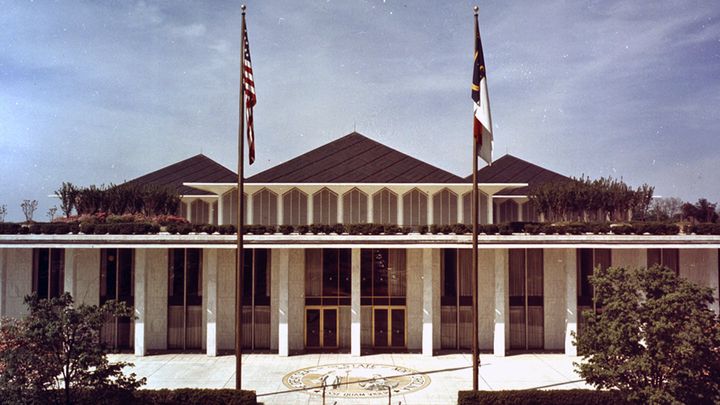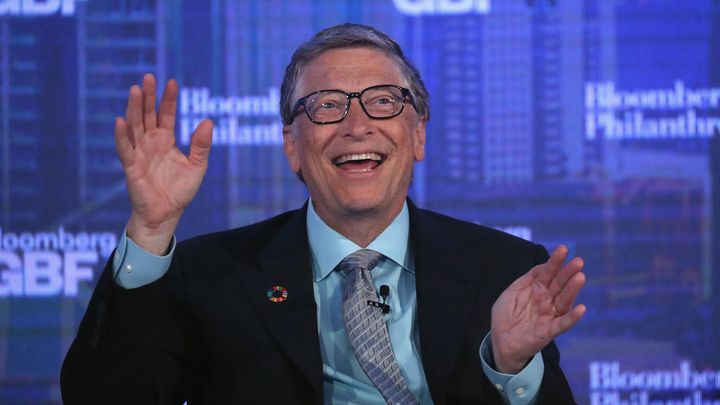This post was authored by independent journalist Jeremy Borden, co-founder of Code for Democracy Kathy Qian, and reporter Michael Taffe.
A masked “Scary Movie”-type character sits holding a coffee cup emblazoned with an emoji at a kitchen counter and, in a sing-songy voice, says: “Terri wants to defund the police. Defund the police? That’s scary liberal!”
The attack ad against North Carolina state Senate Democratic challenger Terri LeGrand from her GOP incumbent opponent, Joyce Krawiec, is a humorous, flippant bite that was just a blip in terms of the overall spending during 2020’s historically expensive election—just a few hundred dollars and around a few thousand impressions on Facebook, according to the site’s political ad tracker.
It was also categorically false, blatantly misrepresenting LeGrand’s position on police reform.
But advertising like “Scary Terri,” coupled with the millions of dollars that outside groups spent to push similar messaging, a strong turnout for President Trump and a under-estimated GOP voter registration effort, worked for Republicans in North Carolina and elsewhere at the state level.
The GOP gained four seats in the North Carolina House and Democrats’ netted just one in the state Senate in a year when Democrats focused on state House and Senate races and unprecedented donations poured in from all around the country because of a focus on the upcoming redistricting, a process of drawing legislative lines that takes place only every 10 years and is a key in who controls Congress and statehouses.
Given the massive amount of funding and focus on statehouse races, this project, funded by the North Carolina Open Government Coalition, sought to isolate and analyze how campaign finance and interlocking national and state power networks work in state legislative races. North Carolina made history with the most races where one or both candidates exceeded the $1 million mark, said Anna Beavon Gravely, the executive director of NC FREE, an organization that advocates for business interests and tracks money in politics.
We did this through network analyses, a type of spatial analysis most often used in fraud detection, counter-terrorism and other fields. Visual analyses of the relationships between different kinds of people and entities in North Carolina’s legislative races are rarely if ever applied to campaign finance data outside of academic research settings.
The resulting visuals and underlying data allow for a more nuanced understanding of the financial interplay between candidates, their donors and the myriad other groups that play a role in funding politics at the state level. The analysis also helps show how an ad like “Scary Terri,” and the money that pays for such ads, are important factors in determining the balance of power.
A look from a bird’s eye view of campaign finance spending in legislative races shows a somewhat unsurprising picture given the stakes in the 2020 election: both parties and candidates awash in campaign cash from various sources.
A closer look reveals how power players interact.
Any analysis of campaign finance spending is just a partial picture—in this case, the numbers analyzed are through the third quarter of last year, as fourth quarter financials were due this week; the project used only a subset of total data available due to technical issues associated with how the data is stored by the North Carolina State Board of Elections; and some groups are not required to disclose what they spend on campaigns or advertising. The project also only analyzed committee transfers rather than all spending.
Given limitations in tracking campaign finance data, this analysis focused on the 10 most expensive and 10 closest legislative races. We also examined state House and Senate races as a whole by analyzing committee transfers through the third quarter of last year. Those numbers and the resulting network analysis show how money moved within Democratic and Republican networks. The analysis revealed:
- Large corporate political action committees from key industries—healthcare, energy and real estate—contributed in all of the top ten close races the analysis examined. Corporations, though, tended to favor incumbents, which were more often members of the GOP.
- Even when candidates do not directly receive money from special interest PACs, some of this money may indirectly end up in their pockets, as campaigns often pass money to each other. In the races analyzed here, Democratic candidates in safe races who receive special interest money passed money to challengers in more competitive contests.
- Federal entities are central contributors to both Democratic and Republican candidates, but on the Democratic side side they tend to be PACs, while on the Republican side they tend to be U.S. Congressional candidates or in-state Republican power brokers.
The network visualizations below are a way to explore each of these trends.
For the Senate District 31 race, one of the most expensive races we examined, it’s easy to see in the visualization below how many special interest PACs have given to Senator Krawiec, the Republican incumbent. The colored dots and lines represent specific large corporate interests from specific sectors (use the key on the left to see which ones), and the graphic shows them closer and with specific transfers to Krawiec.
The Democrat in the race, LeGrand, received special interest dollars second-hand. In this case, four Democratic incumbents in safe races sent dollars to LeGrand, some of whom received money from special interest PACs. While they are relatively small amounts, it shows that even candidates who don’t directly receive large dollars from special interests may be a recipient of that money through other means.
LeGrand had outraised her opponents by about $730,000 through the third quarter, a total of $1.9 million, state campaign finance numbers show. She lost by six percent to the Republican incumbent.
Campaign dollars are a key ingredient in any election, and experts say that when the final figures are reported, the total may go north of $60 million for the state House and Senate races alone. Adding the presidential and U.S. Senate campaigns and independent expenditures on advertising from national groups, the total amount spent on politics in North Carolina in the 2019-20 cycle may be close to $1 billion.
The visualization below shows the 10 closest and 10 most expensive races in the statehouse last year. The special interests that were a part of this analysis are at the center of this network visualization.
That means that even though they are physically closer to the GOP candidates in the visualization—meaning that they give more direct contributions to those candidates—being in the center means that they are powerful players for both parties. Interestingly, even though our analysis isolated specific races, other candidates appear because they play a role in passing along money. Democratic Representative Graig Meyer is one of the biggest contributors. He told us in an interview that because he is in a wealthy district and had no challenger, he was able to fundraise on behalf of other Democrats to try to win back a majority. (Search for him in the visualization, and you can confirm that he does indeed take money from a variety of special interests and others and pass it along to candidates in these races.)
A Concerted Democratic Effort
A decade ago, Democrats vowed 2020 would be different.
In North Carolina and elsewhere, the 2010 Tea Party wave ushered in majorities in Congress and in statehouses across the country. The GOP and conservative groups focused an unprecedented amount of time, effort and money at the state level—and reaped their reward through controlling the legislative redistricting process and drawing lines that favored Republicans.
Last year, Democrats said they would rise to the challenge in part by having dedicated groups fundraise specifically around state legislative races and the redistricting issue. The National Democratic Redistricting Committee was led by former Attorney General Eric Holder and groups like Flippable also vowed unprecedented resources for state races.
The analysis below shows how establishment Democratic money flows around even with new players such as the NDRC and Flippable in the game. Groups closely associated with Democratic causes are at the center, with tentacles to the most number of candidates. The N.C. Democratic Party and the associated N.C. Democratic Executive Committee (DEC) are on the periphery of the visualization. It’s clear that those driving money to the greatest number of candidates in the state are the groups at the center like Planned Parenthood, Emily’s List and Lillian’s List, which funds progressive female candidates.
Overall, one might expect North Carolina’s Democratic power players to be at the center. The size of the squares indicate how many candidates and groups they are giving money to (not the size of the donations). So, while a lot of money flows through the in-state Democratic Party committees, the national Democratic interest groups give to a far greater number of candidates. It is a striking example of how out-of-state groups are building influence using a different strategy than in-state Democratic power brokers.
The NDRC gave the maximum contribution to 38 Democratic campaigns in North Carolina through the third quarter, the data show. The bulk of its spending, about 85 percent, went to the several state Democratic Party entities. Flippable maxed out to more than two dozen Democrats but gave about two-thirds of its total spending to the state Democratic Party.
Of the 20 races that the Coalition analyzed—the closest by result and the most expensive by third quarter total—Democrats handily outspent Republicans. Democrats outspent Republicans by a total of $2.7 million in those 10 close races and $2.9 million in the 10 most expensive races.
Breaking Through the Noise
The visualizations of races below show a similar dynamic as the S.D. 31 race discussed above. The Republicans are receiving more special interest cash, while Democrats in safe races help fund those in these more competitive districts. It is also likely that more groups tend to give to Republicans, as indicated by their wide constellations in this graphic, because they are the incumbents. In other words, the number of state corporate interests giving to Republicans is one way of understanding why it’s difficult to be a challenger running against entrenched money and power.
In the 10 expensive races analyzed, Ricky Hurtado and Brian Farkas, in H.D. 9 and H.D. 63 respectively, were the only Democrats to eke out close victories. Democrats won four of the 10 closest races.
“It is becoming increasingly difficult, if not impossible, to break through the noise with state and local issues,” said Representative Graig Meyer, a Democrat who headed the party’s efforts to try to win back the N.C. House.
Democrats were not able to combat a “defund the police” mantra from the GOP, amplified in outside mailing—which falsely represented the Democratic House candidates’ positions, he said. Coupled with the GOP’s strong turnout, it made for a difficult year in a state Trump won by 1.4 percent statewide.
“In my mind what it shows is that Trump and the Republicans were able to bundle their negative messages effectively up and down the ticket,” Meyer said in an interview. “The media universe that we’re in right now makes it very difficult to have an in depth discussion of any issues down at the local legislative level.”
Republican Money Controlled by State Powerbrokers
In contrast to Democratic spending, the GOP visualization shows in-state groups wielding the most amount of influence. The leaders in the party itself are the influential players. For example, GOP House Speaker Tim Moore’s campaign committee has one of the largest squares, indicating that he gives to a large number of candidates on his side of the aisle. Also unlike the Democrats, the PACs associated with the Republican Party have the most number of donations to the party’s candidates.
Dylan Watts, director of the Senate Republican Caucus that controls the Senate Majority Fund, agreed. He said Trump’s get-out-the-vote effort coupled with strong fundraising and messages that worked — he cited the LeGrand “Scary Terri” ad as a favorite—were the keys to victory. Republicans hit the “defund the police” messaging in mailers, on TV, and on Facebook.
Republican donors were receptive throughout, Watts said. “When they realized how much was on the line and how much was against, they stepped up,” Watts said.
Groups like Citizens for a Better NC, an independent expenditure group, also spent vast sums in the state, giving the GOP a cushion across its races, Watts said. The group was one of several shadowy GOP groups WRAL sought to track, finding it difficult, if not impossible, to see where the money attacking Democrats had originally come from.
The data also show that corporate PAC donors play a role in helping the GOP maintain its majority.
Most political action committees (PACs), or organizations that receive contributions and spend on candidates or issues, are partisan and only donate to candidates from one party. But corporate PACs tend to contribute to incumbents regardless of party. The NC Realtors PAC, Duke Energy Corporation PAC, and the Blue Cross & Blue Shield of NC Employees PAC were the three largest contributors among corporate PACs this cycle. All three backed incumbents in the House and Senate’s five closest races—6 Republicans and 2 Democrats. For example, both Democrat Sydney Batch and Republican John Szoka from a nearby district received the support of the highest spending corporate PACs. Both were incumbents.
In all of the races for House and Senate that ended within a margin of 10 points, these PACs either contributed to the Republican candidate or didn’t contribute at all.
Meyer, a Democratic House member, decried the corporate money in his GOP counterparts’ campaigns. “There are times when I wonder, how can corporations continue to financially support candidates that consistently use rhetoric and take action that is in conflict with some of those corporations stated values?,” he said of donations to Republicans.
Meyer said GOP messaging was “a dog whistle to stoke race-based fears and animosity,” but it successfully drowned out local issues.
North Carolina’s statewide political spending this cycle may total more than $1 billion including the U.S. Senate and presidential races. “The idea that we would spend nearly a billion dollars on campaigns in the middle of a pandemic and a huge economic crisis, it’s just ridiculous,” Meyer said.
To change the system, Democrats will have to win majorities. And to do that, they’ll need campaign cash. “I feel so conflicted,” Meyer said. “I’m sickened by the fact that that’s what you have to do.”
This project was funded by the North Carolina Open Government Coalition, which is a nonpartisan nonprofit group dedicated to improving access to public information and educating citizens about the importance of government transparency.
Jeremy Borden is an independent researcher and journalist who lives in Durham, N.C, and writes at Untold Story. Michael Taffe covers the General Assembly as a reporter based in Chapel Hill, N.C. Kathy Qian is the Co-Founder and Executive Director of Code for Democracy, a 501(c)(3) nonprofit that builds automated tools that uncover hidden relationships between campaign contributions, political narratives, and legislative outcomes in US politics.
This project, sponsored by the North Carolina Open Government Coalition, used data from the N.C. State Board of Elections and the Federal Elections Commission through the third quarter.
The North Carolina data presented significant challenges that could have introduced potential errors into our dataset. Specifically, candidate committees and PACs are required by law to report receipts and expenditures to the State Board of Elections on a quarterly basis. But while the Federal Elections Commission (FEC) collects unique identifier codes for both the contributor and recipient committees for federal transactions, North Carolina’s State Board of Elections collects a free response entry for the names of recipient committees.
This means that there can be significant ambiguity in identifying recipient committees when there are differing committee name formats or typos on disclosure reports. While this can be annoying for traditional campaign finance analyses that total amounts contributed or received, it makes it nearly impossible to build a comprehensive network of campaign spending in the state without significant amounts of manual labor de-duplicating committee names and matching them to their appropriate State Board of Elections identifiers.
We are immensely grateful to Michael Taffe for taking on the majority of this intensive labor.
Read more from Sludge:



